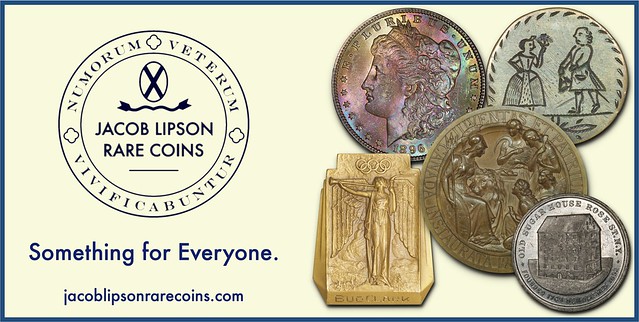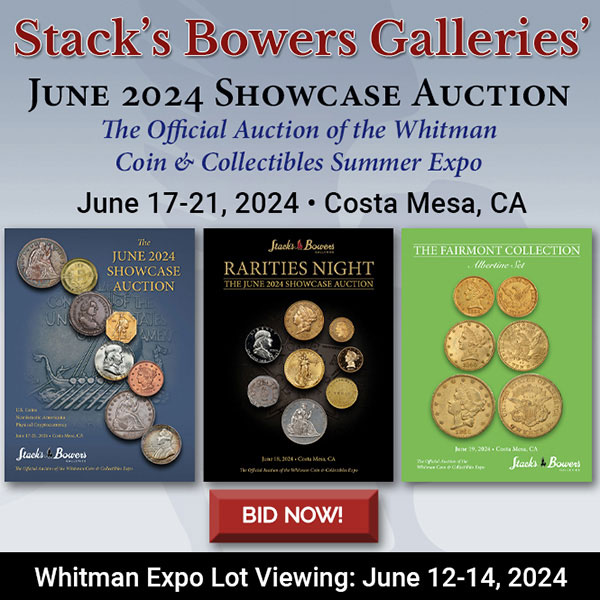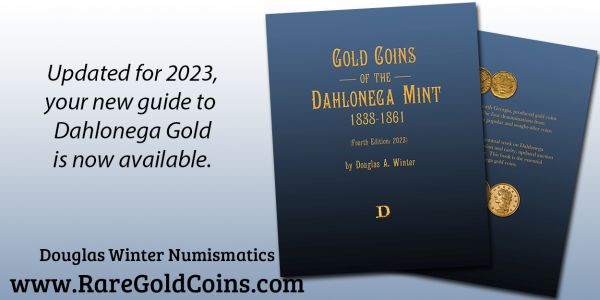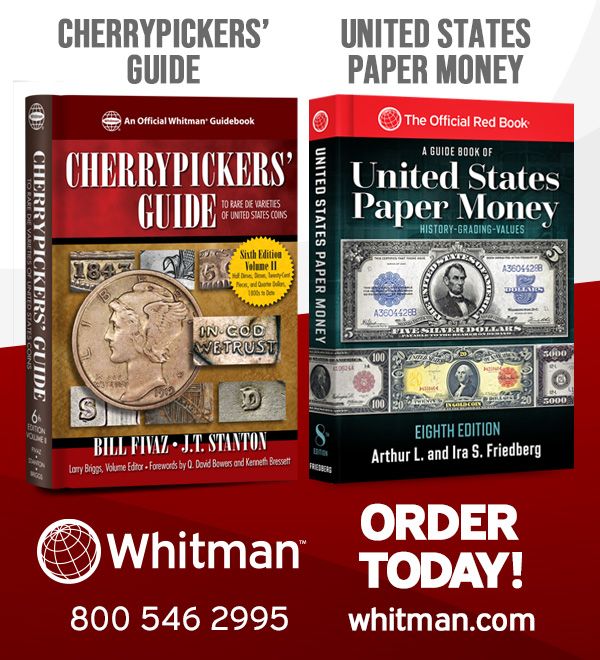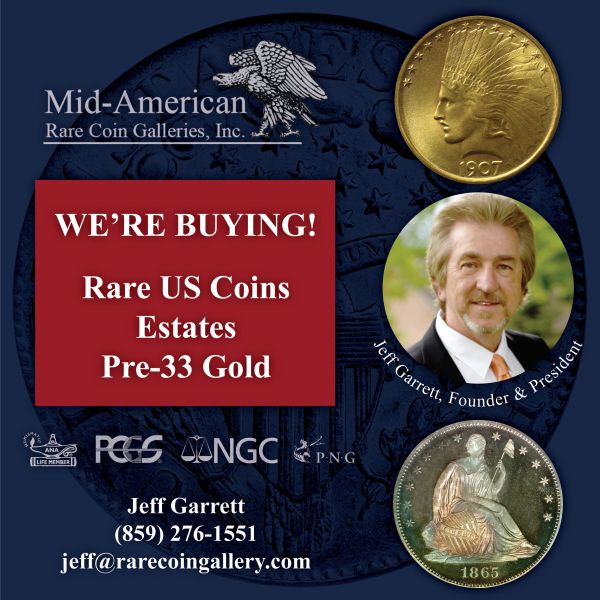
Visit our NBS Sponsors



About UsThe Numismatic Bibliomania Society is a non-profit association devoted to the study and enjoyment of numismatic literature. For more information please see our web site at coinbooks.org SubscriptionsThose wishing to become new E-Sylum subscribers (or wishing to Unsubscribe) can go to the following web page link MembershipThere is a membership application available on the web site Membership Application To join, print the application and return it with your check to the address printed on the application. Print/Digital membership is $40 to addresses in the U.S., and $60 elsewhere. A digital-only membership is available for $25. For those without web access, write to: Jeff Dickerson, Treasurer AsylumFor Asylum mailing address changes and other membership questions, contact Jeff at this email address: treasurer@coinbooks.org SubmissionsTo submit items for publication in The E-Sylum, write to the Editor at this address: whomren@gmail.com BUY THE BOOK BEFORE THE COIN |
- WAYNE'S WORDS: THE E-SYLUM JUNE 16, 2024
- NEW BOOK: U.S. COIN DIE VARIETIES
- NEW BOOK: FOUNDATION PHILOSOPHY OF WOODEN COINS
- GREG BENNICK INTERVIEWS STAN KESSELMAN
- VIDEO: JOSEPH WRIGHT, MINT ENGRAVER
- COIN BOARD HOARD UPDATE AND INTERVIEW
- NOTES FROM E-SYLUM READERS: JUNE 16, 2024
- VOCABULARY TERM: PLATE, PLATING
- CALVIN WESLEY FRANKLIN (1855-1911)
- MORE ON C. W. FRANKLIN
- RICHARD LUBBOCK, UK COIN DEALER GONE BAD
- 2024 CANADA $20 NUNAVUT COMMEMORATIVE
- HERITAGE AUCTIONS GERMAN STATES SALE
- HERITAGE AUCTIONS ERROR COINAGE SALE
- DAVISSONS E-AUCTION 49: LELAND SCOTT COLLECTION
- STACK'S BOWERS BRUUN COLLECTION PART I
- THE COINS OF DIOCLETIAN
- ANCIENT COIN FIND IN LOD, ISRAEL
- MEDALS OF THE FRENCH REVOLUTION
- NEW HAVEN BICENTENNIAL MEDAL
- THE FREE STATE OF BOTTLENECK
- VISITING ROYAL JOHANNES ENSCHEDE
- MAGNET FISHERS TAKE THIER BOOTY TO THE BEP
- MONEY HIDDEN IN HOMES
- MORE CARELESS CASH STASHES
- LOOSE CHANGE: JUNE 16, 2024
Content presented in The E-Sylum is not necessarily researched or independently fact-checked, and views expressed do not necessarily represent those of the Numismatic Bibliomania Society.
WAYNE'S WORDS: THE E-SYLUM JUNE 16, 2024
 New subscribers this week include:
Welcome aboard! We now have 7,255 subscribers.
New subscribers this week include:
Welcome aboard! We now have 7,255 subscribers.
Thank you for reading The E-Sylum. If you enjoy it, please send me the email addresses of friends you think may enjoy it as well and I'll send them a subscription. Contact me at whomren@gmail.com anytime regarding your subscription, or questions, comments or suggestions about our content.
This week we open with two new books, updates from the Newman Numismatic Portal, notes from readers, and more.
Other topics this week include U.S. Coin Die Varieties, wooden coins, coin boards, C. W. Franklin, Richard Lubbock, auction previews, an ancient coin find, medals of the French Revolution, and the Free State of Bottleneck.
To learn more about Stan Kesselman, Joseph Wright, Donald Kocken, Democratic Wild Cat Money, an 1804 Silver Dollar tattoo, the Numismatic Blue Book, error coins, German, Scottish and Swedish coins, Royal Johannes Enschede, and money payable in coon skins, read on. Have a great week, everyone!
Wayne Homren
Editor, The E-Sylum
NEW BOOK: U.S. COIN DIE VARIETIES
Robert Powers has published a two-volume guide to U.S. Coin Die Varieties. The volumes are sold separately. -Editor
U.S. Coin Die Varieties, Variety Identification and Pricing Guide
by Robert Powers
Volume One of a comprehensive variety identification or cherrypicking guide covering a combined total of the TOP 325+ MOST VALUABLE AND POPULAR U.S. Coin die marriages, varieties, and errors. This, the first Volume of two, covers Half Cents, Large Cents, Small Cents, Two Cents, Nickels, and Half Dimes.
Volume Two covers Dimes, Quarters, Half Dollars, Dollars, and Gold coins.
NEW BOOK: FOUNDATION PHILOSOPHY OF WOODEN COINS
Anatoly Saltykov-Karpov passed along information about his new monograph on wooden coins. -Editor
 The brochure presents the results of scientific and practical research on the development and application of wooden money to increase the efficiency in business, social and political life in a democratic society. New edition.
The brochure presents the results of scientific and practical research on the development and application of wooden money to increase the efficiency in business, social and political life in a democratic society. New edition.
Publication Date: Mar 5, 2024
Language: English
ISBN: 9781304591586
Pages: 90
Binding: Perfect Bound
Dimensions: Digest (5.5 x 8.5 in / 140 x 216 mm)
GREG BENNICK INTERVIEWS STAN KESSELMAN
The latest addition to the Newman Numismatic Portal is an interview with coin dealer Stan Kesselman. Project Coordinator Len Augsburger provided the following report. -Editor
Greg Bennick Interviews Stan Kesselman
 Stan Kesselman, a NY coin dealer, worked parttime in numismatics without a store front, quietly trading between the leading dealers and collectors of the day, beginning around 1960. Among his clients were the well-known collectors Harry W. Bass, Jr., R. L. Miles, and Ted Naftzger. Kesselman specialized in rare date U.S. gold and was involved in transactions such as the purchase of the Naftzger $20 Liberty set, complete from 1850-1907.
Stan Kesselman, a NY coin dealer, worked parttime in numismatics without a store front, quietly trading between the leading dealers and collectors of the day, beginning around 1960. Among his clients were the well-known collectors Harry W. Bass, Jr., R. L. Miles, and Ted Naftzger. Kesselman specialized in rare date U.S. gold and was involved in transactions such as the purchase of the Naftzger $20 Liberty set, complete from 1850-1907.
Greg Bennick has interviewed a number of numismatic personalities for Newman Portal, capturing stories to inspire the next generation of numismatists. He is a longtime specialist in error coins and board member of the Combined Organization of Numismatic Error Collectors of America (CONECA). In 2023, he reported the discovery of a unique, multi-denominational mated-pair error involving a 3-cent nickel piece and a Shield nickel.
THE BOOK BAZARRE
VIDEO: JOSEPH WRIGHT, MINT ENGRAVER
The David Lisot Video Library on the Newman Numismatic Portal can be found at:
https://nnp.wustl.edu/library/multimediadetail/522852
We highlight one of his videos each week in The E-Sylum. Here's one from 2005 with Scott Rubin speaking about engraver Joseph Wright. -Editor
COIN BOARD HOARD UPDATE AND INTERVIEW
Justin Hinh passed along these updates on the Coin Board Hoard he's helping disperse. -Editor
I wanted to pass along two quick updates on the Coin Board Hoard.
 1) To make it easier to see what is in the hoard, readers can now go to
www.CoinBoardHoard.com. It will redirect them to the full 1700+ inventory sheet.
1) To make it easier to see what is in the hoard, readers can now go to
www.CoinBoardHoard.com. It will redirect them to the full 1700+ inventory sheet.
2) While I was in Greenbay, Wisconsin to catalog the hoard, I had a chance to sit down and interview Donald Kocken. He authored the book "Collecting Vintage Coin Boards, Albums, Folders, & Holders: 1930's and Beyond" and a large part of the hoard comes from his collection. As a fellow coin album nerd, I knew I had to pick his brain.
I'm sure many readers will enjoy this 52-minute conversation covering his 60+ years in numismatics. They can find the interview on YouTube.
NOTES FROM E-SYLUM READERS: JUNE 16, 2024
1896 Olympic Medal Copies
Bob Fagaly writes:
"I read the article on THE OLYMPIC GAMES THAT AREN'T RECOGNIZED. It stated that “As was customary at the time, the medal is of course not made of pure gold, but gilded silver.“ I believe that this is not correct. The first place finishers received a silver medal. I know this because a friend’s grandfather won one of the track and field events (I won’t specify which one for privacy reasons). He still has his grandfather’s medal and it is not gilded silver, but just silver.
"You might be interested to know that over a century after the first Olympics, the grandson commissioned a jeweler to make 15 copies (in silver) for distribution to all of his descendants. The copies can be identified for the original by the fact that other than tiny casting indicators and the sharpness of the striking, the only clue that sets the original apart from the copies is that the original has the word “argent” clearly struck along the edge and the others do not.
"A side note: There is a small dent in the side of the medal. This was caused by two sons of the winner of the medal, as the boys were chucking it against a brick wall to see who could get it closest."
Ouch. Thanks - great information and story. -Editor
To read the earlier E-Sylum article, see:
THE OLYMPIC GAMES THAT AREN'T RECOGNIZED
(https://www.coinbooks.org/v27/esylum_v27n23a21.html)
Other topics this week include 1892 Democratic Wild Cat Money, an 1804 Silver Dollar Tattoo, and a George III Indian Peace Medal. -Editor
VOCABULARY TERM: PLATE, PLATING
Here's another entry from Dick Johnson's Encyclopedia of Coin and Medal Terminology. -Editor
Plate, Plating. A very thin layer of metal deposited on a base metal by the process of electroplating. Metals of an inexpensive alloy or composition are plated with a more expensive metal; for example zinc is plated with copper; brass, bronze, copper, nickel-silver, white metal is plated with silver; and any of these are plated with gold. Thus the plated object – manufactured at low cost – can be given the finish, color and texture of the more expensive metal.
CALVIN WESLEY FRANKLIN (1855-1911)
E-Sylum Feature Writer and American Numismatic Biographies author Pete Smith submitted this article on enigmatic author and publisher C. W. Franklin. Thanks! -Editor
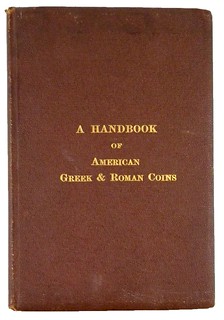 Wayne asked me to find out what I could about Calvin Franklin and a book being sold by Kolbe
& Fanning with the Homren library.
Wayne asked me to find out what I could about Calvin Franklin and a book being sold by Kolbe
& Fanning with the Homren library.
Calvin (age 6, born in Ohio) appeared in the 1860 Census with his father, John Franklin (1826-1908), his mother, Nancy Franklin (1833-1916), a brother, John (8), and his sister, Sarah Jane (2). His father was listed as a farmhand in the State of Ohio. The brother listed as John was probably James.
Calvin (age 16) appeared again in the 1870 census in Washington County, Ohio, with his parents, James (18), Mary (10) and John (5). The father was still a farmhand.
For the 1880 Census, John and Nancy are living in Ravenswood, West Virginia, with Mary (19), John William (14) and Lucy (6). I did not find Calvin in 1880. The 1890 Census has been generally lost.
MORE ON C. W. FRANKLIN
But wait - there's more! Pete Smith also included this group of clippings with additional mentions of C. W. Franklin. Thanks, everyone! -Editor
I had a draft of my article completed this week by Noon on Friday, June 14. Then I received several interesting clippings from Julia Casey. I think they add something to the original story.
This item was published in Mehl’s Numismatic Monthly, Vol. 1, No. 4. Page 71. April 1908.
RICHARD LUBBOCK, UK COIN DEALER GONE BAD
From a ship sailing between Greenland and Iceland, Richard Lobel of London's Coincraft writes:
"On Amazon TV see Breaking Dad about Richard Lubbock, coin dealer turned dope dealer. I am quoted in part of it, but have not seen it as yet. Several people have said it is worth watching."
Thanks to Richard's prompt, I found a great article about this in The Jewish Chronicle about this OTHER Richard. Here's an excerpt - see the complete article online. Sad, but fascinating story. -Editor
... Richard’s bad memory isn’t just down to old age; he’s a drug addict and dealer who was responsible for Metropolitan Police’s largest-ever haul of crystal meth once they had caught up with him at his east London penthouse flat. Expecting to find a hardened gangland boss, they discovered, instead, a skinny Jewish geek who liked classical music and war documentaries.
His story is just as insane as that of Breaking Bad’s Walter White; a chemistry teacher who turns crystal meth manufacturer and gun-toting dealer when he discovers he has cancer and cannot pay for the treatment.
2024 CANADA $20 NUNAVUT COMMEMORATIVE
Much of numismatics is devoted to learning about the background of how coins come to be. Here's an article interviewing the designer of a new Canadian commemorative coin. -Editor
 Aija Komangapik says she hopes a piece of her art featured on a new $20 silver coin showcases the joyful and funny side of Inuit life.
Aija Komangapik says she hopes a piece of her art featured on a new $20 silver coin showcases the joyful and funny side of Inuit life.
The coin, recently issued by the Royal Canadian Mint, features an Inuk mother who represents Nunavut. She’s dancing in the midnight sun with a large amauti spread out behind her, filled with smaller people who represent Nunavummiut.
The mint released the coin to commemorate Nunavut’s 25th anniversary.
HERITAGE AUCTIONS GERMAN STATES SALE
Here are several highlights from the June 2024 Heritage German States Showcase Auction. Great coins! -Editor
Heritage's June 23 German States Showcase Auction proves a richly curated event highlighting the vast numismatic history of the many German States that issued coinage in their own names. This auction features several conditional outliers from the ever-popular City View and Wildman Taler series, balanced by absolute rarities from lesser-seen states such as Hohenlohe and the Teutonic Order. Noteworthy too is the strong showing of gold Prussian 10 and 20 Mark, alongside a sprinkling of scarce Ducat and Siege issues.
One of the outstanding offerings in this auction is a 1759-FWôF Taler from Saxony. Graded MS66 by NGC, this is a jaw-dropper in every sense. This is the first instance our firm has offered this type, reputably difficult to source and bringing strong premiums in all states of preservation. Furthermore, this is the highest grade awarded by either major service, the next highest example coming in three whole points lower. Luster is abundant, swirling around the wood-grained pewter and baby blue patina, appearing as a singular pool of toned splendor. The devices, although low relief, have retained incredible detail. This wonder coin is surely one of the top prizes in this auction.
HERITAGE AUCTIONS ERROR COINAGE SALE
Another June 2024 Heritage auction features error coins. Some "striking" pieces here - these mistakes reveal the manufacturing process behind the coins we collect, and make us all more knowledgeable collectors. -Editor
Numismatic errors are coins that were minted incorrectly due to a mishap in the minting process. These errors can occur at various stages of production, making each error coin unique. Some errors are relatively common, while others, like mules, are extremely rare and highly prized by collectors. Error coins provide a fascinating insight into the vulnerabilities and imperfections of the minting process and are a popular collecting area for those interested in the unusual and unique aspects of numismatics. Our June 17 Showcase Auction of Error Coinage features quite a number of these unintended byproducts of the minting process.
Double-denomination coin errors are among the most fascinating and sought-after types of minting errors in numismatics. These errors occur when a coin that has already been struck with one denomination is mistakenly fed back into a press and struck again with a die of a different denomination. The result is a coin that features overlapping designs of two different denominations, making it a rare and intriguing collector's item. This auction features a number of such errors, such as lot 50095, a 1994 cent struck on an already struck 1993 dime.
DAVISSONS E-AUCTION 49: LELAND SCOTT COLLECTION
Here's another update from Davissons on their upcoming sale. Nice coins. -Editor
Coins from the Leland Scott Collection anchor our June 26th sale. Carefully assembled over many years, this remarkable collection features a significant offering of Scottish coinage, an area where even modest pieces can be hard to find. In addition, the collection features select British hammered and ancient Greek and Roman. The sale concludes with important Scottish references, making this auction a perfect opportunity for Scottish collectors whether just beginning or advanced.
Particularly note the low denomination billon and copper pieces. If you have ever looked for quality examples of these lowly coins, you know they are particularly difficult to find. Billon was not all that stable to begin with and Scotland was not a place where the people who used these low denomination pieces would (or could) leave them sitting around for later generations. I recall trying to locate examples to show when Chuck Bianchi and I were teaching an ANA seminar and it turned out that over a several month period, I found almost nothing to take to the course. (English coins were much easier to find….)
STACK'S BOWERS BRUUN COLLECTION PART I
Here's a preview from Stack's Bowers Galleries of their first sale of the Bruun collection, coming up in September. Some beautiful coins here. -Editor
The L. E. Bruun Collection is coming to market beginning with Part I on September 14, 2024, after a century-long slumber. Bruun, a native of Denmark, began collecting coins as a boy in the 1850s and collected up to the time of his passing in 1923. He was the preeminent collector of Scandinavian coinage in his day, leaving behind a collection of about 20,000 Danish, Norwegian, and Swedish coins, medals, tokens and banknotes, in addition to a world-class numismatic library.
A unique provision in his will set aside his collection as a reserve for the Royal Danish Coin and Medal Collection for a period of 100 years. If the Royal Collection was somehow lost or destroyed, the Bruun Collection would become a gift to the Danish state. If the Royal Collection survived the century intact, then his collection would be auctioned off to the benefit of his direct descendants. The 100-year waiting period came to an end on November 21, 2023, and with the Royal Collection intact, Bruun’s vast collections became destined for the auction block.
The inaugural auction features nearly 300 gold and silver rarities spanning a period of over four centuries, from the 1496 gold noble of King Hans, the first gold coin issued by a Danish king, to coins that would have circulated in Bruun’s own lifetime. Select highlights from Part I of the collection are featured below, while a preview of the complete auction can be viewed by clicking here.
THE COINS OF DIOCLETIAN
Mike Markowitz published an article for CoinWeek on the coins of Diocletian. Here's an excerpt - see the complete article online. -Editor
THE ABUNDANT AND complex coins of Diocletian document a period of profound change in Roman history.
In November 284, Roman soldiers escorting the ailing emperor Numerian’s coach across Anatolia smelled a foul odor. When they opened its curtains, they found the emperor had been dead for some time. Suspicion fell on Lucius Flavius Aper, the Praetorian Prefect. Diocles, commanding the imperial bodyguard, accused Aper of murdering the emperor and executed him on the spot. The legions immediately proclaimed Diocles as emperor, who renamed himself Diocletianus–usually written in English as “Diocletian”.
A tough soldier of humble origin from Dalmatia (the coastal region of modern Croatia), Diocletian would rule for 20 years, ending the chaotic “military anarchy” that had tormented the empire for five decades. Realizing that the Roman Empire had become too large for one man to manage, he made his trusted friend Maximianus co-emperor in the West, ruling from Trier in Germany and later from Milan in Italy. Diocletian himself ruled in the East, establishing his capital at Nicomedia (modern Izmit, Türkiye). To ensure a smooth succession, each emperor later appointed a junior colleague (designated as Caesar) in a system that historians call the Tetrarchy[2]. Maximian chose Constantius Chlorus as his junior colleague, while Diocletian chose Galerius, sealing the deal by giving Galerius his daughter in marriage.
ANCIENT COIN FIND IN LOD, ISRAEL
Aaron Oppenheim and Laurence Edwards passed along articles about a find of ancient coins in the central Israeli city of Lod. Thanks. -Editor
Archaeologists have uncovered a hoard of silver and bronze coins dating from the 4th century CE buried in the foundations of an ancient, destroyed Jewish public building in the central Israel city of Lod, the Israel Antiquities Authority (IAA) announced on Sunday.
The 94 coins were probably buried for safekeeping during the events of the Gallus Revolt (351-354 CE), a lesser-known Jewish uprising against Roman rule in the land of Israel, but the building was destroyed and the coins were never recovered, the IAA said.
MEDALS OF THE FRENCH REVOLUTION
John and Nancy Wilson passed along this article from the Ashmolean Museum at Oxford University about their excellent medal collection. Thank you. -Editor
The eighteenth century saw the beginnings of a considerable fashion for the production of medals, which gave a platform for the recording and dissemination of information on current events.
The French Revolution, which began in 1789, took place at a time when medallic art was evolving, and the Revolution itself fueled the developments. The dramatic and controversial events that took place in this period were interpreted from many angles.
The Ashmolean Museum holds a fine collection of medals celebrating, commemorating, and lamenting these events; the storming of the Bastille, the abolition of the French monarchy, the executions of the king and queen, and the major constitutional reforms, during the period 1789-1793. Explore a selection of medals, made in France and abroad, that represent these turning points in French history.
NEW HAVEN BICENTENNIAL MEDAL
An article by Stack's Bowers Senior Numismatist Greg Cohen highlights a great U.S. Mint medal in their upcoming sale. -Editor
One of the many U.S. Mint medals struck in the 19th century and cataloged by R.W. Julian is the 1838 Bicentennial of New Haven, Connecticut medal. Struck in both bronze and silver, both sides depict the major transformation of the Elm City, from its founding in 1638 by a company of 500 Puritan settlers to a major port city. This masterpiece from the U.S. Mint was designed by Charles Cushing Wright.
The obverse displays members of the settler company with Rev. John Davenport preaching to his followers below what can be presumed to be an elm tree. Members of the native Quinnipiack tribe look on and the ridges of South Mountain can be seen in the background. The words QUINNIPIACK and 1638 appear at the upper legend.
THE FREE STATE OF BOTTLENECK
Dick Hanscom passed along this article about the obscure between-the-world-wars European "country" of the Free State of Bottleneck. Thanks! -Editor
... did you know that not long ago, there was a place whose government called itself the “Free State of Bottleneck”? I’m not kidding. Here are some details:
- The Free State of Bottleneck, nestled between France and Germany, existed for four years and a month, from January 1919 to February 1923, and boasted a population of 17,000.
- Its capital was Lorch, a town on the Rhine River, whose mayor was elected the country’s president.
- It issued its own passports, coin, currency, and stamps, all highly prized by collectors to this day.
- Because it wasn’t formally recognized by its neighboring countries, Bottleneckers couldn’t trade openly with the French or the Germans. So they earned a living by smuggling and by occasionally hijacking a train or a boat.

VISITING ROYAL JOHANNES ENSCHEDE
Owen Linzmayer edits The Banknote Book. Here's an excerpt from his Greysheet article on his recent visit to the historic security printing company Royal Johannes Enschede in the Netherlands. See the compete article online. -Editor
 One of the highlights of my recent trip to the MIF Paper Money Fair in Maastricht was attending a presentation by Marcel Klok, Sales Director Banknotes, of the storied Dutch security printer Royal Johannes Enschedé. His presentation briefly touched on the history of the firm established in 1703, and gave a nice overview of the process of banknote printing from conception, design, approval, and mass production. While Enschedé no longer prints legal tender banknotes for nations, they are still a major player in printing other security documents such as passports and stamps, as well as “commercial banknotes” for private entities that capitalize on their expertise in anti-counterfeiting features and distinctive numismatic designs.
One of the highlights of my recent trip to the MIF Paper Money Fair in Maastricht was attending a presentation by Marcel Klok, Sales Director Banknotes, of the storied Dutch security printer Royal Johannes Enschedé. His presentation briefly touched on the history of the firm established in 1703, and gave a nice overview of the process of banknote printing from conception, design, approval, and mass production. While Enschedé no longer prints legal tender banknotes for nations, they are still a major player in printing other security documents such as passports and stamps, as well as “commercial banknotes” for private entities that capitalize on their expertise in anti-counterfeiting features and distinctive numismatic designs.
MAGNET FISHERS TAKE THIER BOOTY TO THE BEP
Last week we discussed the New York magnet fishers who pulled up a small safe with stacks of hundred dollar bills. Here's an excerpt of a follow-up from the New York Times, recounting the couple's journey to the Bureau of Engraving and Printing in Washington. D.C. -Editor
James Kane was bleary-eyed as he climbed onto the upper deck of a Megabus, wearing a cowboy hat with stickers and carrying a backpack that contained a small fortune.
He’d only gotten three hours of sleep the night before, as the previous day had been a blur of interviews with news wires, TV stations and radio programs. He was headed to Washington, more specifically to an obscure branch of the Treasury Department that dealt with mutilated currency.
It all started when he hoisted a safe out of a creek in Flushing Meadows Corona Park in Queens. Ever since losing his job during the pandemic, Mr. Kane had been trying to establish himself as a magnet fisherman with a YouTube channel. He had the cops on speed dial as someone who regularly found computer hard drives, gun parts and the occasional live grenade.
MONEY HIDDEN IN HOMES
Another New York Times article looks at the issue of people hiding cash in their homes, and the problems faced by their heirs. -Editor
After their father died in 2021, Susan Camp and her brother cleaned out his home — and inadvertently threw out $5,000 in cash he had wrapped in aluminum foil and stashed in the freezer. (Luckily, they later retrieved it.)
It might not be under the mattress, but for people who stumble across a small fortune after an elderly relative dies or moves to a nursing home, uncovering such unexpected wealth — technically part of a person’s estate — can bring complications and even conflict.
Oftentimes, members of older generations perceive keeping cash, gold or other valuables at home as safer than keeping them in a bank, experts say. “I think this is more common for the baby boomer generation and older,” said Mark Criner III, senior trust strategist for Baird Trust in Scottsdale, Ariz. “When you get to that generation, there was a real mistrust of financial institutions,” he said, referring to people old enough to remember the Great Depression and the bank failures of the 1930s.
MORE CARELESS CASH STASHES
An article published this week by Stacks Bowers Currency Specialist Michael Moczalla highlights the problem discussed in the previous articles in this issue. Cash laying around the house (hidden or not) is at risk of being lost, stolen or carelessly given away. -Editor
Almost 30 years ago, I received a call from a dealer friend of mine who worked in a small coin shop in northern Illinois. He mentioned a woman came in with seven uncirculated early $5 Legal Tender notes. Five turned out to be scarce 1928B $5 replacement notes in Gem Uncirculated condition. These notes were found in a book purchased at a local book fair. Her $1 purchase turned out to be valued in the thousands of dollars. It happens all too often; sometimes very rare notes are placed within the pages of a random book to be dealt with later. Often the notes are forgotten, creating a windfall for others.
Fr. 1527*. 1928B $5 Legal Tender Star Note. PMG Gem Uncirculated 66 EPQ. | Stacks Bowers
LOOSE CHANGE: JUNE 16, 2024
Here are some additional items in the media this week that may be of interest. -Editor
Over on CoinWeek, Roger Burdette published the first of a series of articles on the making of the Peace Dollar, adapted and updated from his book, Renaissance of American Coinage 1916-1921. Here's a short excerpt - see the complete article online. -Editor
An American silver dollar commemorating peace was a nice idea, but it was also mired in post-war complexity.
1920 ANA Convention members discussed the subject and decided to appoint a committee “…to cooperate with government officials to secure the issue of a Peace-Victory coin, and to aid in the selection of a design and size of the coin.” The “Peace-Victory Commemorative Committee” consisted of Judson Brenner, chairman; J.M. Henderson, MD; Howland Wood (American Numismatic Society curator); Farran Zerbe (coin dealer); and William A. Ashbrook (United States House of Representatives, D-OH17).
Representative Ashbrook was a coin collector, a six-time member of the United States Mint’s Assay Commission, and a former chairman of the House Committee on Coinage, Weights, and Measures. He should have brought considerable clout to the ANA’s efforts. But when the Republican Party gained control of the House in 1918, Representative Albert Henry Vestal (R-IN8) replaced him as committee chairman; Ashbrook was defeated for reelection in November 1920. Nevertheless, Vestal and Ashbrook were friends, and Ashbrook was well-regarded by committee members from both parties. He used his waning influence to persuade Vestal to call an informal committee meeting on December 14, 1920, to hear the ANA’s suggestions for a peace commemorative. Of the ANA members appointed to the committee, only Brenner, Henderson, and Ashbrook attended the House Coinage Committee meeting.
To read the complete article, see:
Making the Peace Dollar, Part One: Stuck in Committee
(https://coinweek.com/a-victory-peace-dollar-part-one-stuck-in-committee/)
Other topics this week include Tossed-Out Coins, and Canada's New King Charles III Banknotes. -Editor
















